
Sage Agastya once recounted the story of Hanuman to Lord Rama. Upon Mount Sumeru dwelled Keshari, a formidable leader among the Vanaras. His wife, Anjana, possessed unparalleled beauty. One day, Vayu, the wind god, beheld Anjana standing alone and felt a desire to unite with her. In his mystical yogic form, Vayu joined with her, resulting in the conception of a child named Hanuman. Anjana placed the infant amidst reeds as she gathered forest fruits. Hanuman, hungry, gazed at the sun and leaped, thinking it was a colossal fruit. Empowered by his divine lineage, he ascended towards the sun. Vayu accompanied him, enshrouding him with a refreshing breeze to shield him from the sun’s scorching heat. Recognizing Hanuman’s destined role as a devoted servant of Vishnu, the sun-god withheld his intense rays.
While Hanuman soared through the skies, a demon named Rahu approached the sun, intending to obscure it and create an eclipse. Hanuman perceived Rahu and thwarted his advance. Rahu fled to the heavens, imploring Indra, the king of gods, to address the situation. Indra, riding his celestial elephant Airavata, ascended to the sky to confront Hanuman, who resembled a blazing meteor. Mistaking Indra for another fruit, Hanuman turned towards him. Indra hurled his thunderbolt, striking Hanuman and causing him to plummet to earth.
Hanuman collapsed atop a mountain, seemingly lifeless. Witnessing this, Vayu induced suffocation in all creatures by disrupting their life forces. This turmoil in the universe compelled Indra and the gods to intercede. They beseeched Vayu to cease his actions. Brahma arrived and inquired about the cause of Vayu’s distress. Vayu explained that his son had been struck down, prompting Brahma to revive Hanuman with a touch. Hanuman awoke, and Vayu restored the life airs in all beings. Brahma prophesied Hanuman’s significance as a devoted servant of Vishnu and advised the gods to bestow boons upon him.
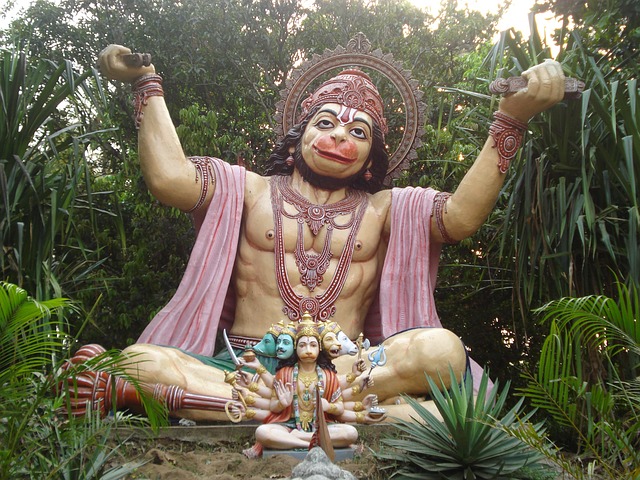
Indra placed his garland around Hanuman’s neck, rendering him immune to his thunderbolt. The sun-god granted a portion of his brilliance to Hanuman and the ability to swiftly grasp all forms of knowledge when studying scriptures. Yamaraja ensured Hanuman’s immunity to his rod and freedom from ailments. Kuvera blessed him with unwavering stamina in battle. Śiva declared Hanuman’s invulnerability to his weapons and death at his hands. Viśvakarma proclaimed that Hanuman would be impervious to celestial weapons forged by him and enjoy longevity.
Lastly, Brahma declared Hanuman’s invincibility in battle, his transformative abilities, unrestricted movement, and resistance to Brahmin curses. He prophesied Hanuman’s valor in war, leading to Ravana’s downfall and Rama’s triumph.
With the gods’ blessings, Vayu returned Hanuman to his mother. Hanuman grew, exuding divine power. Fueled by his own might and the mischievous nature of monkeys, he teased forest sages. Despite attempts to control him, Hanuman persisted, provoking the ascetics.
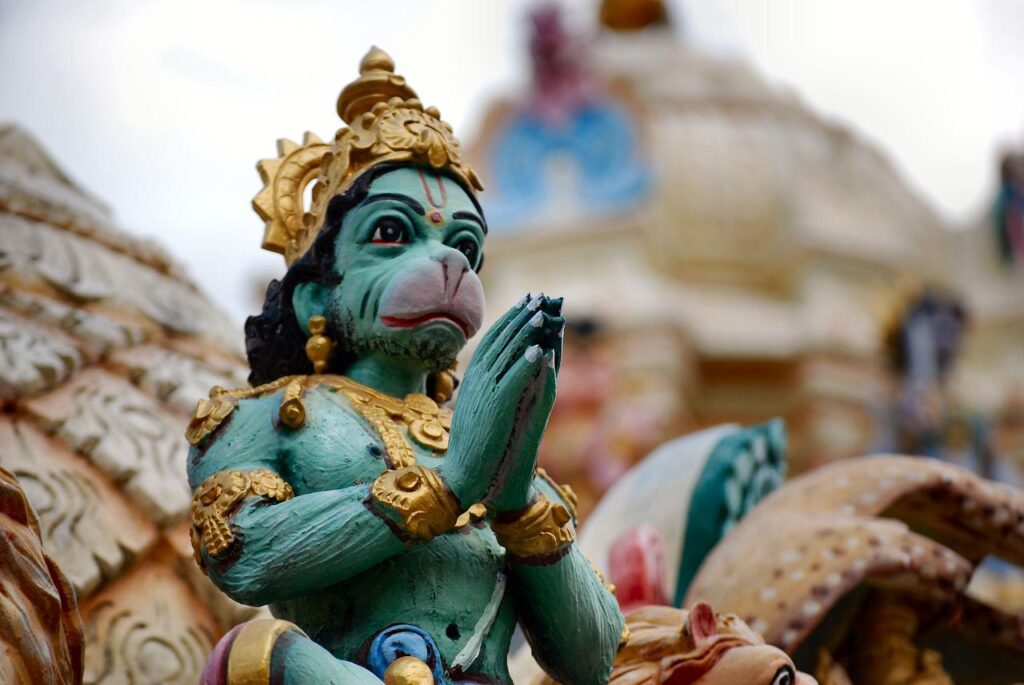
To curb Hanuman’s behavior without harming him, the sages devised a solution. Their leader, using sacred water, invoked a curse. Hanuman would forget his strength and recall it only when his glories were recited. Bewildered by the curse, Hanuman adopted the life of an ordinary Vanara. He befriended Sugriva, accompanying him into exile after Vali’s banishment. His strength resurfaced when reminded by Jambavan during the search for Sita, setting the stage for his extraordinary feats in the service of Lord Rama.
Hanuman and His Unwavering Love for Lord Rama
Hanuman’s unwavering devotion to Lord Rama is truly inspiring. Despite having numerous admirable qualities, his unparalleled love and dedication to Rama stand out the most. He had complete faith in the power of Rama’s holy name, which enabled him to perform incredible feats, such as constructing a bridge of massive rocks across the ocean for Rama’s army to reach Lanka. When Rama and Lakshmana were gravely injured, and the only way to save them was to bring the sanjeevani herbs from the Gandhamadana mountain, Hanuman fearlessly lifted the entire mountain and brought it to Lanka. In another instance, when he set fire to the city of Lanka, the demons’ fortress, he did so by chanting Rama’s name and even burned his own tail in the process.
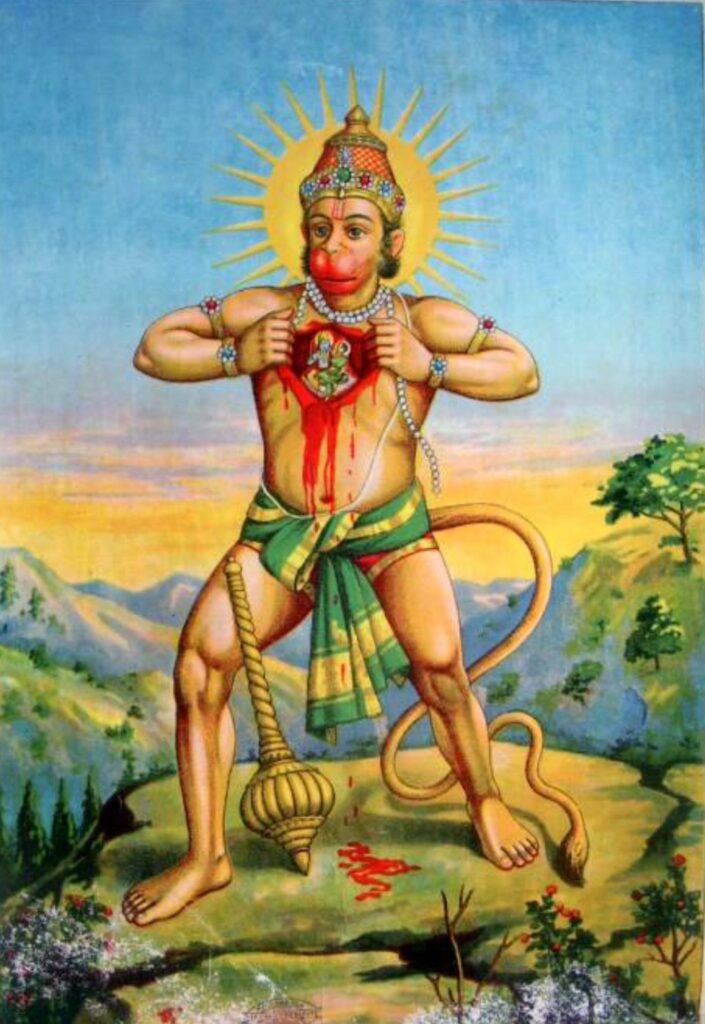
Hanuman’s devotion is often depicted in art and literature, showing him kneeling with folded hands in front of Rama, Sita, and Lakshman, or opening his chest to reveal an image of Rama and Sita in his heart. Hanuman’s strength, intelligence, and wisdom are a perfect combination, making him an exemplary bhakti yogi. He used his gifts fearlessly and with great love and sincerity to serve the Divine. His love for Rama serves as a beautiful example of devotion that inspires millions to this day.
Hanuman’s Leap to Lanka in search for Sita
The monkey army waited on the southern shore of the ocean and discussed how they could cross over to reach Lanka and find Sita. Angada suggested that he could leap a distance of eight hundred miles, but he was unsure if he would have enough strength to return. Jambavan, who had grown old, expressed that he could only cover as much as seven hundred miles. However, nobody was confident enough to make the leap to Lanka and return.
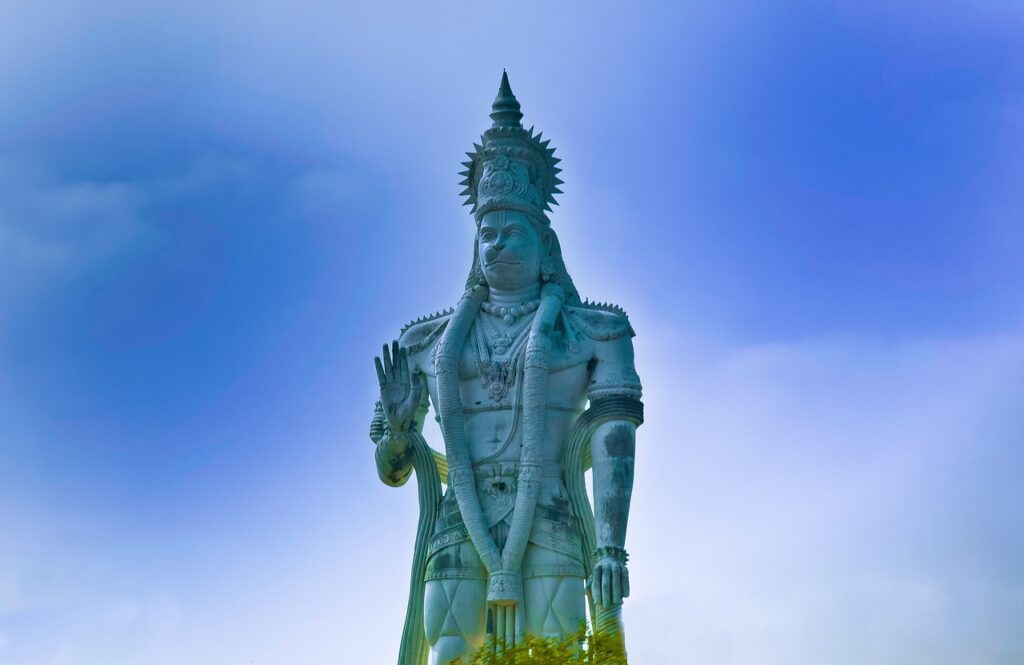
Jambavan then turned to Hanuman, the son of the wind god, who was immensely powerful. Jambavan described Hanuman’s birth and power. Soon after his birth, Hanuman had leaped for a thousand miles wanting to catch the sun, but was struck down by Indra. This angered Vayu (wind god), and as a result, the wind ceased to blow in the universe. The demigods sought to appease Vayu by bringing Hanuman back to life and blessing him with wonderful powers. Hanuman became fearless as a young child, playing mischievously at the hermitages of the sages, throwing about their paraphernalia and preventing their sacrifices. The sages cursed Hanuman so that he forgot about his great powers, but also granted him the boon that he would remember his great powers once he heard about them from someone else.
Now that Jambavan was describing Hanuman’s powers, the curse was broken, and Hanuman recalled his great strength and abilities. Hanuman expanded to fifty times his normal height and assured the monkeys that he could easily leap across the ocean to Lanka. As instructed by Angada, Hanuman agreed to only find Sita and report back, instead of trying to rescue her on his own. Pressing Mount Mandara deep into the earth and letting out a great cry of ‘Victory to Rama,’ Hanuman leaped from its peak towards Lanka.

As Hanuman continued his flight, he was attacked by Surasa, the mother of Nagas, who assumed the form of a terrible Rakshasi that threatened to swallow him. Hanuman requested her not to hinder his mission, but Surasa insisted on swallowing Hanuman. Hanuman grew to a length of sixteen miles, and Surasa expanded her mouth accordingly. Hanuman continued to grow longer, but Surasa could not match his length, so Hanuman quickly contracted to the size of a thumb, entered her mouth, and came out quickly. Surasa revealed her original form as the mother of Nagas and blessed Hanuman with all success.
As Hanuman continued his flight, he was attacked by Simhika, who seized Hanuman’s shadow with her mystic powers to try and devour him. This checked Hanuman’s flight. However, Hanuman entered Simhika’s mouth and tore open her heart and vital organs from inside the body before bursting out from the other side. Simhika fell dead.
Hanuman soon saw the shores of Lanka, skirted by forests and high mountains. The city of Lanka was built by Viswakarma on the peak of the Trikuta mountain. As Hanuman stepped on the land, he began to think of the best way to enter the city.
Hanuman was amazed by the grandeur of Lanka, with hundreds of tall, impressive buildings embellishing white-tiled roads, making it appear like the capital of Gods. Despite being guarded by terrible Rakshasas, Hanuman waited for sunset to enter the city. However, the presiding deity of Lanka stopped him, revealing herself as Ravana’s servant, and challenged him. Hanuman hit her, and she surrendered, acknowledging that her defeat by a monkey signaled the end of Rakshasas. Hanuman entered the city in the shape of a small monkey, discovering golden chariots, palanquins, aerial cars, and many other grand things, but could not find Sita in Ravana’s palace.
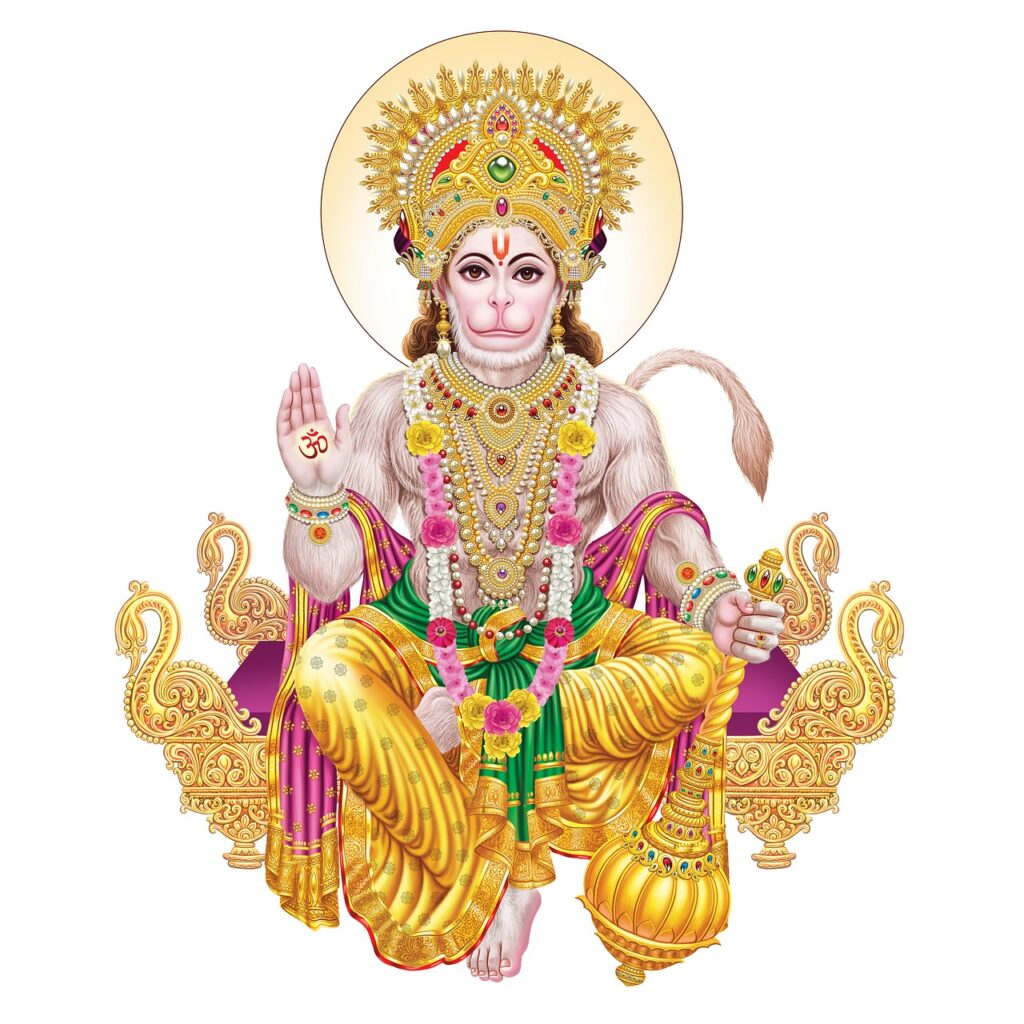
Finally, he saw Sita in the palace gardens, surrounded by Rakshasis who teased and tormented her. After Ravana left, Hanuman introduced himself to Sita, reassured her of Rama’s loyalty by showing her his ring, and asked to take her to Rama. However, Sita refused, fearing that it would be difficult to hold onto Hanuman while flying, and Rakshasas would chase them, making it difficult for Hanuman to retaliate.
Hanuman sets Lanka ablaze
Reassuring Sita, Hanuman decided to return to Rama with information about Sita’s whereabouts. In Lanka, before his departure, Hanuman desired to inflict some damage. He let out a mighty scream and began causing havoc, tearing down walls and archways. Taking up a huge iron bar, he stood eagerly at the entrance of the garden, waiting for the demons to arrive. Upon hearing of Hanuman’s actions, Ravana immediately sent eighty thousand Rakshasas to capture him. However, chanting the glories of Rama, Hanuman assumed an even bigger form and started killing the demons in thousands. Ravana then sent Jambumali, one of his generals, to fight Hanuman, who struck Hanuman with powerful arrows, causing him to bleed. But Hanuman’s rage was triggered, and he came down heavily on Jambumali’s chariot, crushing the demon’s head into a shapeless mass with his iron rod.

Realizing Hanuman’s immense power, Ravana sent more of his generals to defeat him, but they were all killed effortlessly by Hanuman. Ravana then turned to his sons and sent Prince Aksha to fight Hanuman. Aksha rode his golden chariot, yoked by swift celestial steeds, and fired powerful arrows that struck Hanuman, causing him to bleed. Witnessing the intense battle between Hanuman and Aksha, the demigods were astonished. But Hanuman seized the opportune moment and killed all eight of Aksha’s steeds, causing his chariot to crash to the ground. Hanuman then caught hold of Aksha’s legs, spun him violently, and dashed him to the ground, causing his bones to shatter, and he died.
Filled with grief and fury, Ravana turned to his eldest son, Indrajit, who had previously defeated and even captured Indra in battle. The battle between Indrajit and Hanuman was fierce, but neither could overpower the other. Finally, Indrajit used the infallible Brahmastra weapon presided over by Lord Brahma himself to strike Hanuman. However, Hanuman had received a boon that he could not be overpowered by Brahmastra except for a brief period of time. When Hanuman was struck, he willingly agreed to be captive to meet Ravana. Hanuman feigned fear as he was dragged to the palace on Indrajit’s order, and when the effect of Brahmastra wore off, he identified himself as a servant of Lord Rama and demanded the release of Sita, warning Ravana to beg for Rama’s mercy.
Ravana became furious and wanted to kill Hanuman, but Vibhishana intervened and convinced Ravana not to kill Hanuman, who was only a messenger. Hanuman’s punishment was decided as his tail being set on fire, and he would be paraded around the streets of Lanka. But Sita prayed to Agni, the god of fire, to protect Hanuman, and Agni heeded her prayers, making the fire on his tail go cold. Hanuman then reduced his size and escaped from the thick ropes that tied him, and with chants of ‘Victory to Rama,’ he set fire to the mansions of Lanka with his flaming tail. Several buildings fell, blazing to the ground, and fear struck the hearts of Rakshasas.
Undeterred, Hanuman turned adversity into an opportunity and continued to punish the Rakshasas on behalf of his master, causing the whole of Trikuta mountain to blaze. When Rakshasas attacked him, Hanuman killed them in thousands. He set the entire Lanka on fire, except for where Sita was being held captive. After delivering enough punishment to the Rakshasas, Hanuman decided to return, shouting Rama’s name as he leaped across the mountains.
Hanuman in Mahabharata
There is a less-explored aspect of history concerning the placement of Hanuman’s flag on Arjuna’s chariot. This is the origin of Arjuna’s name, ‘Kapidhvaja,’ where ‘Kapi’ refers to a monkey. Hanuman, an eternal devotee of Lord Rama, took on the role of accompanying Rama when He incarnated as Krishna and assumed the position of Parthasarathi, driving Arjuna’s chariot in the battlefield of Kurukshetra. Subsequently, during the intense battle between Arjuna and Karna, Hanuman, adorning Arjuna’s banner, made a remarkable leap onto Karna’s flag, creating turmoil as he tore at the jeweled elephant’s rope.